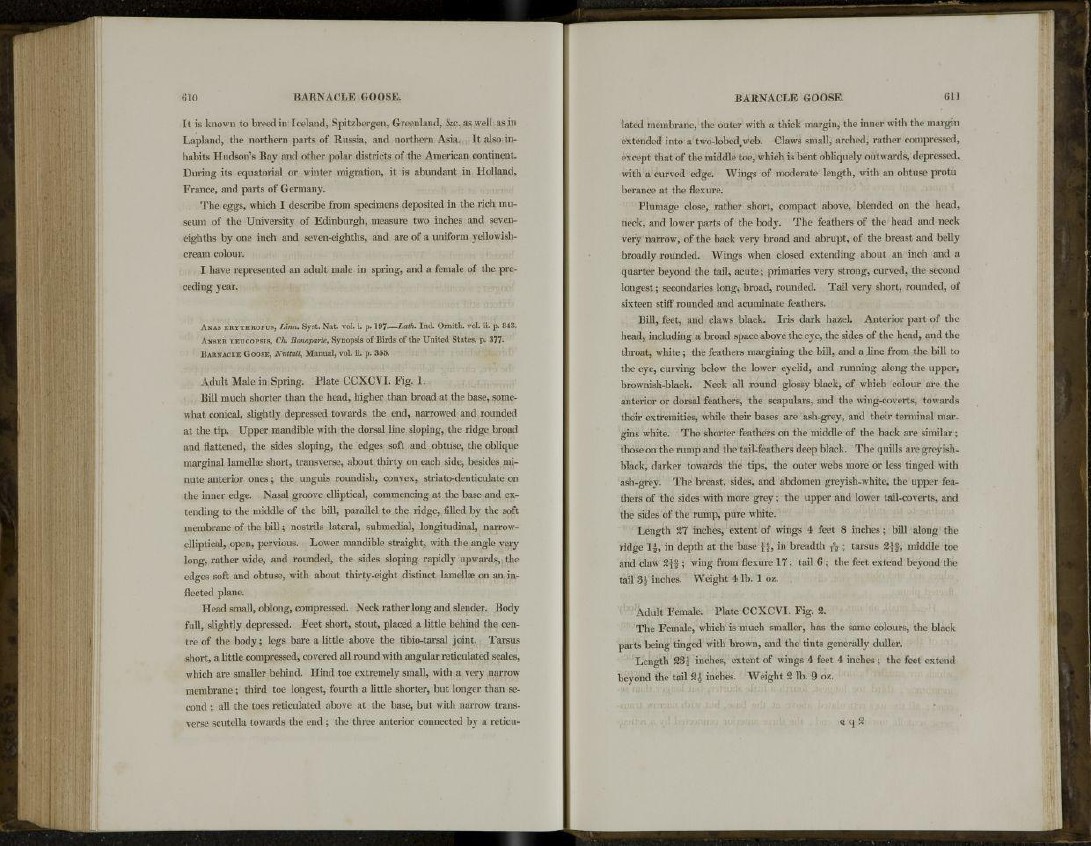
610 BARNACLE GOOSE.
It is known to breed in Iceland, Spitzbergen, Greenland, &c. as well as in
Lapland, the northern parts of Russia, and northern Asia. It also inhabits
Hudson's Bay and other polar districts of the American continent.
During its equatorial or winter migration, it is abundant in Holland,
France, and parts of G ermany.
The eggs, which I describe from specimens deposited in the rich museum
of the University of Edinburgh, measure two inches and seveneighths
by one inch and seven-eighths, and are of a uniform yellowishcream
colour.
I have represented an adult male in spring, and a female of the preceding
year.
ANAS ERYTHROPUS, Linn. Syst. Nat. vol. i. p. 197-—Lath, Ind. Ornith. vol. ii. p. 843,
ANSER LEUCOPSIS, Ch. Bonaparte, Synopsis of Birds of the United States, p. 377-
BARNACLE GOOSE, Kuttall, Manual, vol. ii. p. 355.
Adult Male in Spring. Plate CCXCVI. Fig. 1.
Bill much shorter than the head, higher than broad at the base, somewhat
conical, slightly depressed towards the end, narrowed and rounded
at the tip. Upper mandible with the dorsal line sloping, the ridge broad
and flattened, the sides sloping, the edges soft and obtuse, the oblique
marginal lamellae short, transverse, about thirty on each side, besides minute
anterior ones; the unguis roundish, convex, striato-denticulate on
the inner edge. Nasal groove elliptical, commencing at the base and extending
to the middle of the bill, parallel to the ridge, filled by the soft
membrane of the bill; nostrils lateral, submedial, longitudinal, narrowelliptical,
open, pervious. Lower mandible straight, with the angle very
long, rather wide, and rounded, the sides sloping rapidly upwards, the
edges soft and obtuse, with about thirty-eight distinct lamellae on an inflected
plane.
Head small, oblong, compressed. Neck rather long and slender. Body
full, slightly depressed. Feet short, stout, placed a little behind the centre
of the body; legs bare a little above the tibio-tarsal joint. Tarsus
short, a little compressed, covered all round with angular reticulated scales,
which are smaller behind. Hind toe extremely small, with a very narrow
membrane ; third toe longest, fourth a little shorter, but longer than second
; all the toes reticulated above at the base, but with narrow transverse
scutella towards the end ; the three anterior connected by a reticu-
BARNACLE GOOSE. 611
lated membrane, the outer with a thick margin, the inner with the margin
extended into a two-lobed.web. Claws small, arched, rather compressed,
except that of the middle toe, which is bent obliquely outwards, depressed,
with a curved edge. Wings of moderate length, with an obtuse protu
berance at the flexure.
Plumage close, rather short, compact above, blended on the head,
neck, and lower parts of the body. The feathers of the head and neck
very narrow, of the back very broad and abrupt, of the breast and belly
broadly rounded. Wings when closed extending about an inch and a
quarter beyond the tail, acute; primaries very strong, curved, the second
longest; secondaries long, broad, rounded. Tail very short, rounded, of
sixteen stiff rounded and acuminate feathers.
Bill, feet, and claws black. Iris dark hazel. Anterior part of the
head, including a broad space above the eye, the sides of the head, and the
throat, white ; the feathers margining the bill, and a line from the bill to
the eye, curving below the lower eyelid, and running along the upper,
brownish-black. Neck all round glossy black, of which colour are the
anterior or dorsal feathers, the scapulars, and the wing-coverts, towards
their extremities, while their bases are ash-grey, and their terminal margins
white. The shorter feathers on the middle of the back are similar;
those on the rump and the tail-feathers deep black. The quills are greyishblack,
darker towards the tips, the outer webs more or less tinged with
ash-grey. The breast, sides, and abdomen greyish-white, the upper feathers
of the sides with more grey; the upper and lower tail-coverts, and
the sides of the rump, pure white.
Length 27 inches, extent of wings 4 feet 8 inches; bill along the
ridge 1 2 , in depth at the base in breadth T°2 ; tarsus 2}§, middle toe
and claw 2}§ ; wing from flexure 17; tail 6 ; the feet extend beyond the
tail 3\ inches. Weight 4 lb. 1 oz. .
Adult Female. Plate CCXCVI. Fig. 2.
The Female, which is much smaller, has the same colours, the black
parts being tinged with brown, and the tints generally duller.
Length 23? inches, extent of wings 4 feet 4 inches ; the feet extend
beyond the tail 2 i inches. Weight 2 lb. 9 oz.
o q 2